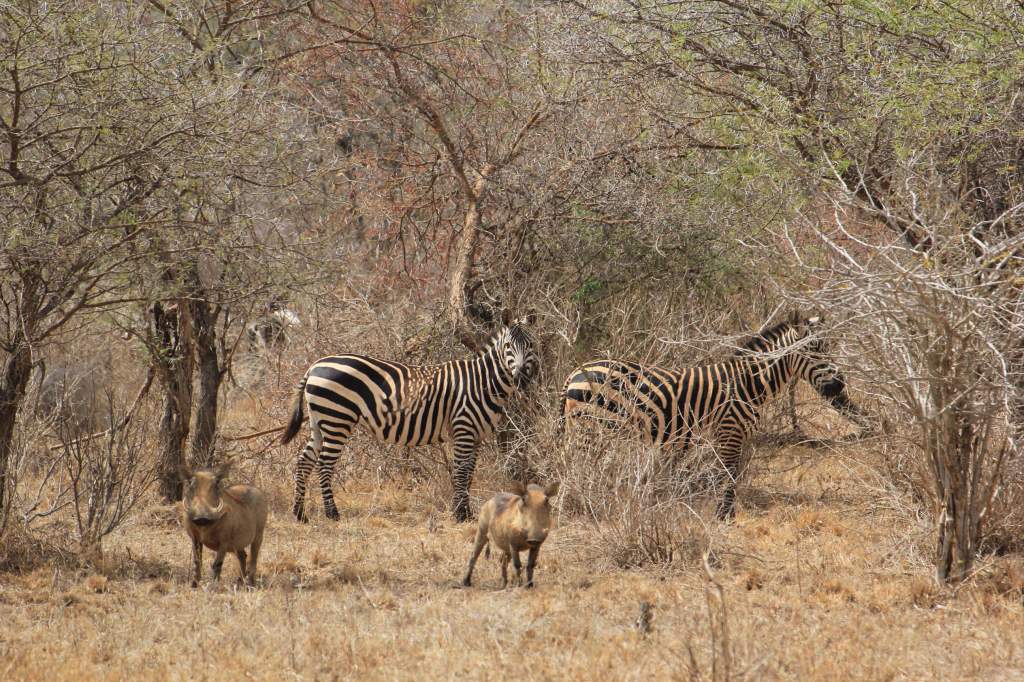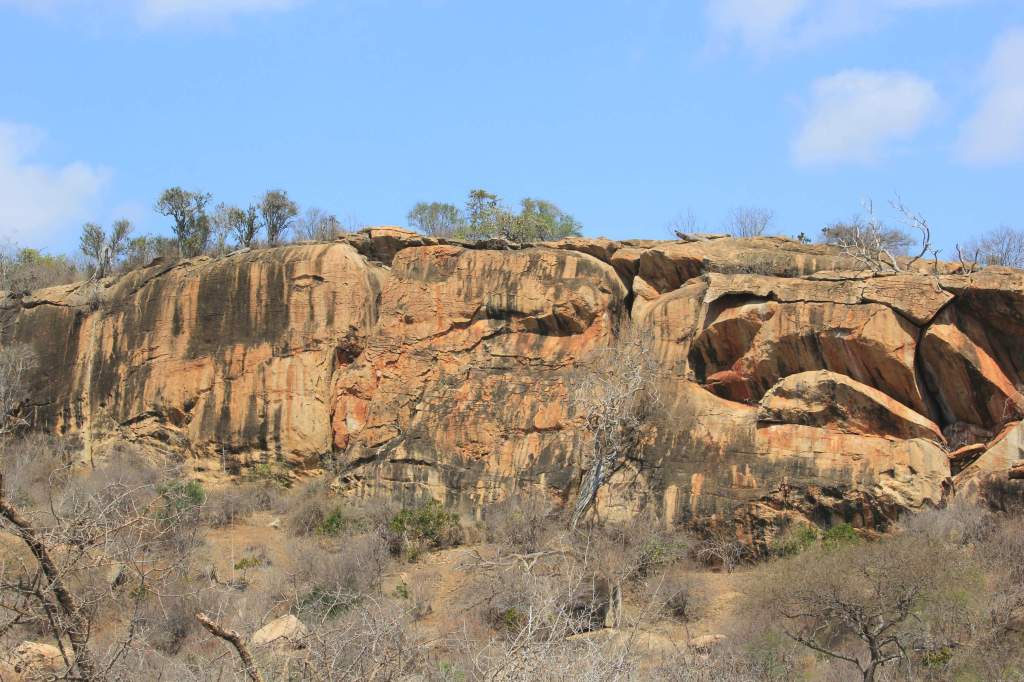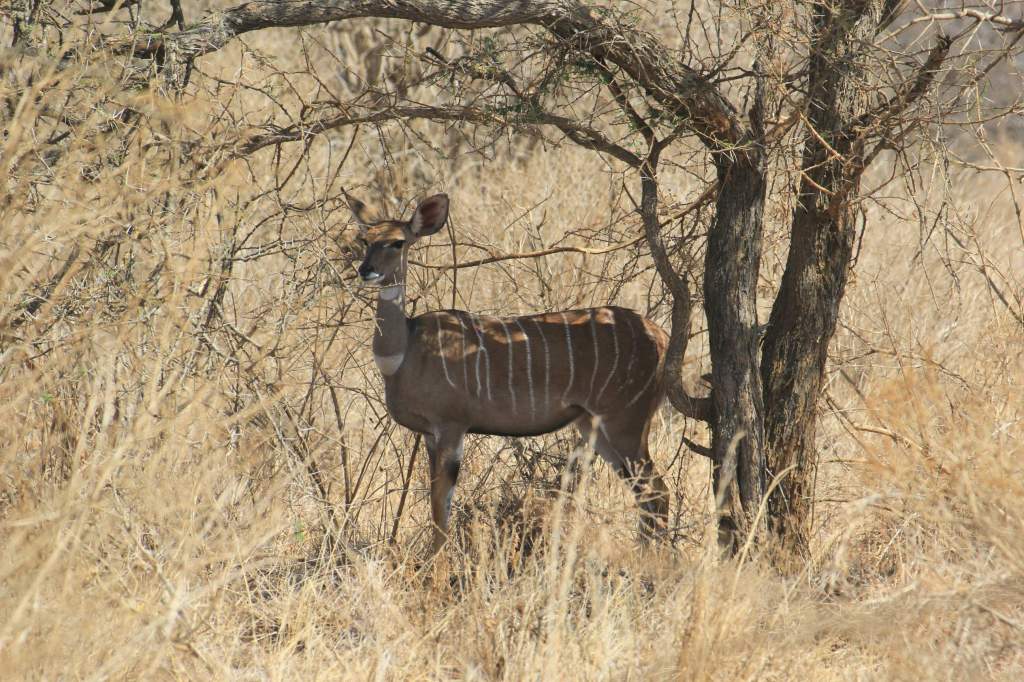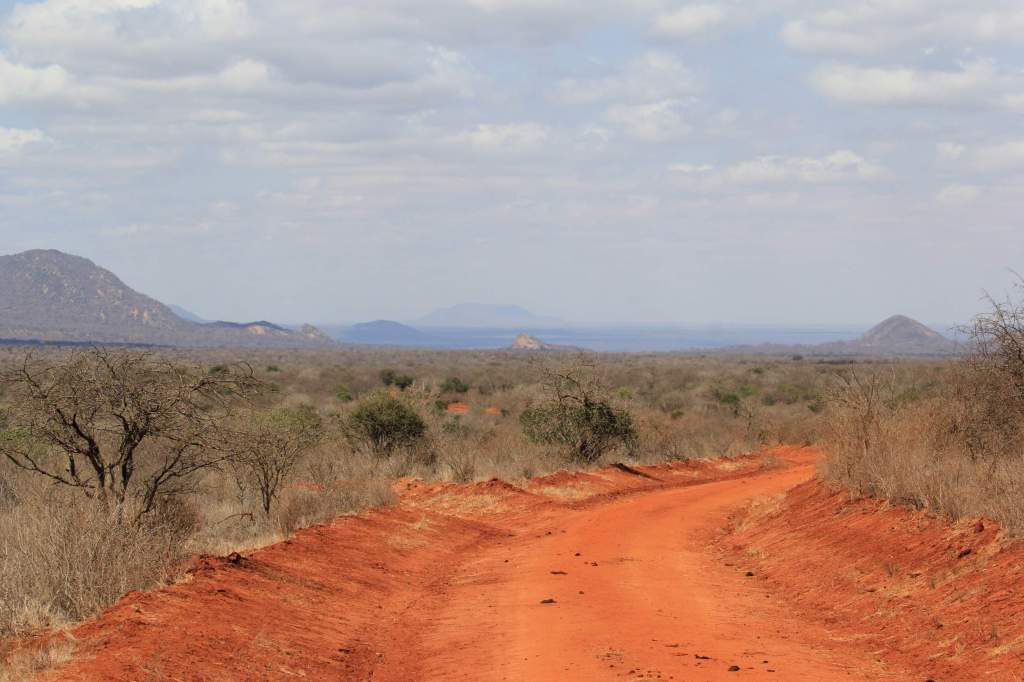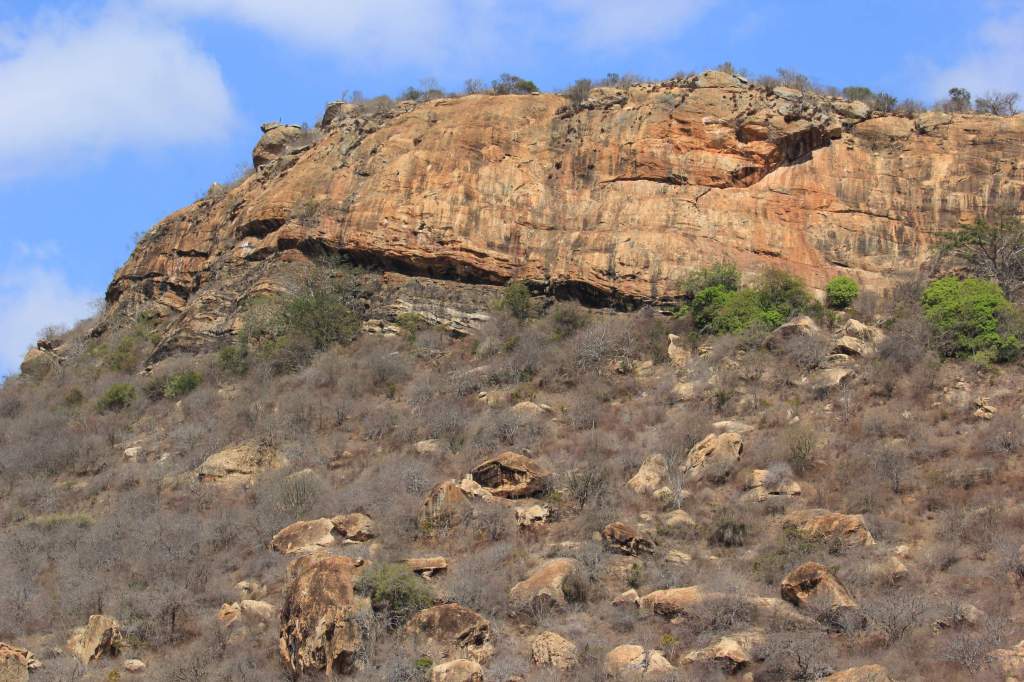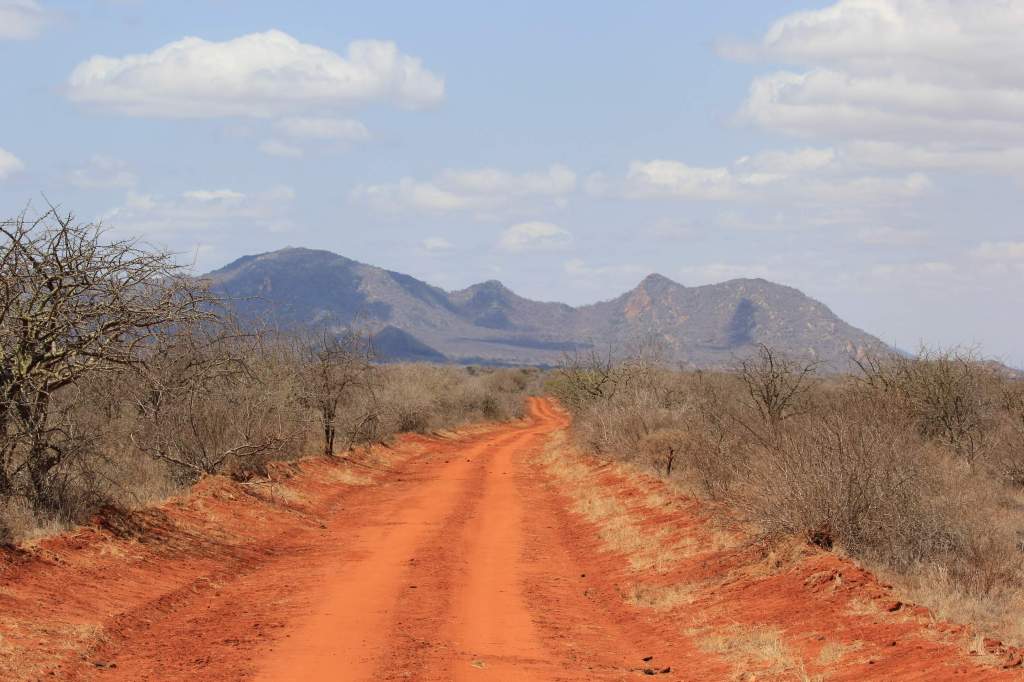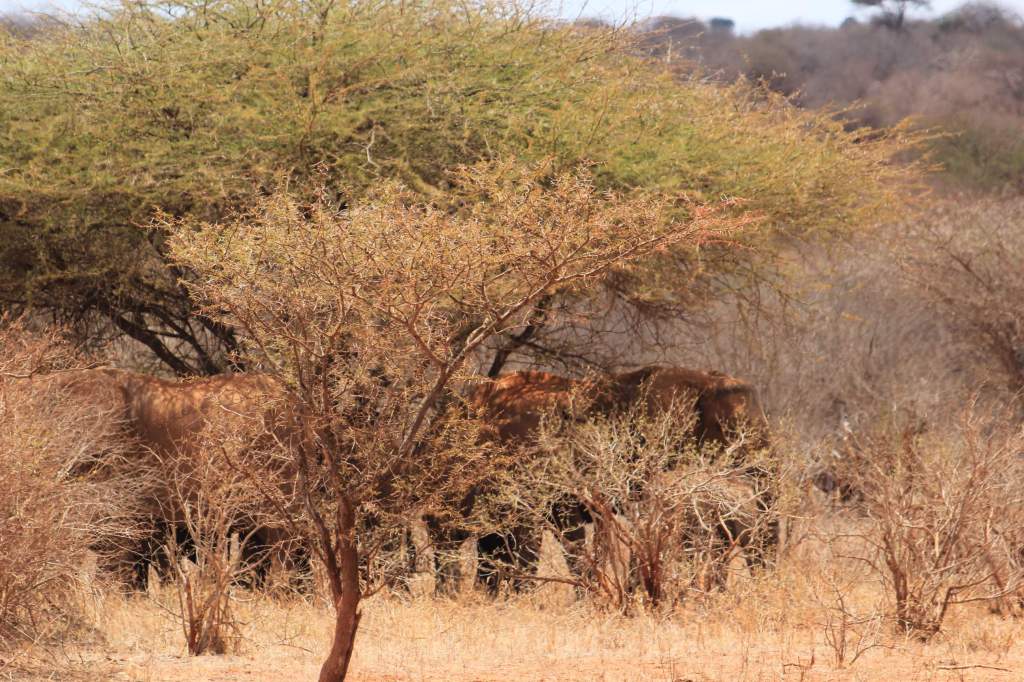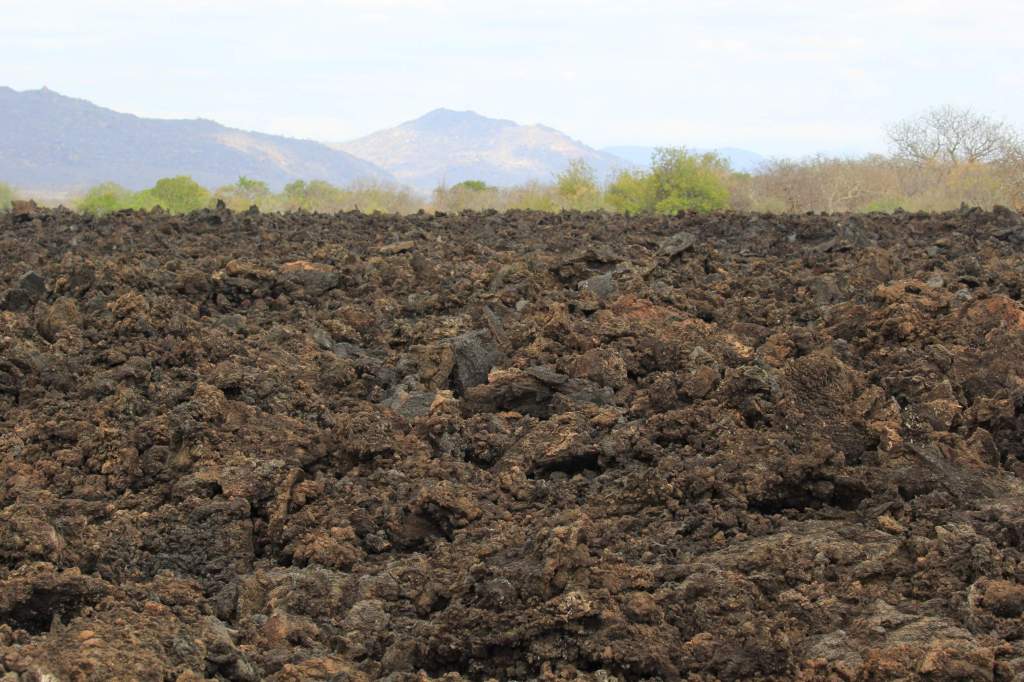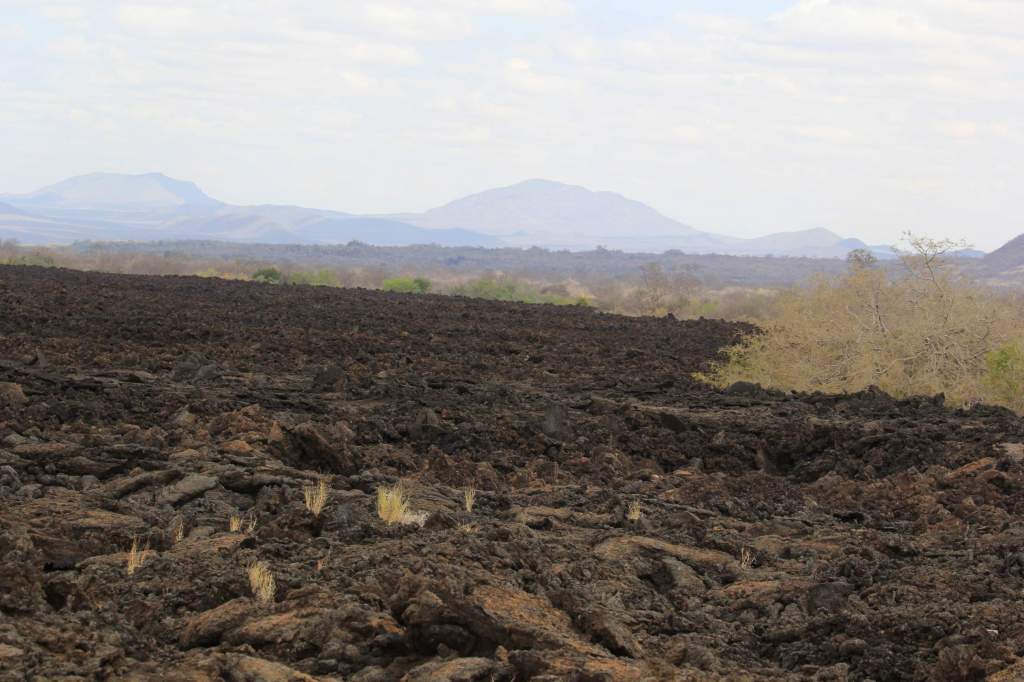Up just before sunrise we were packed up and ready to hit the road as soon as it was light enough. Our first stop was for fuel on the way out of town, we didn’t expect to see another fuel station for a couple of days so we wanted to ensure both tanks were full.
To get to the gate for West Tsavo National Park we had the best part of an hour’s drive back up the Nairobi-Mombassa highway. Traffic was lighter but there was still no shortage of trucks and the road condition was no better condition than the other way. We went past troops of baboons and a lone elephant at the side of the road.
The park was really quiet, we didn’t see many safari vehicles, and as we expected we saw a lot less animals. The bush was quite dense on entering the park – there was probably plenty of wildlife in it but we didn’t see much more than the odd elephant and small antelope.
As the bush opened up we could see the impressive scenery, we decided to take one of the track to the hills. We hadn’t gone far down it before we realised that nothing had been down it for quite some time as there was no tyre tracks, undisturbed animal and the odd branch pushed onto the track by elephants. We went quite a way down it as it took us by lion rock (not that we saw any) we double backed and took a side track however that appeared even less used and deep sand that was almost dust saw us turning round at the first chance we got. We had no desire to get stuck, particularly with so little traffic, and it was deep enough to be stressful rather than enjoyable driving. We could hear the 4WD working hard.
We knew roughly where we were on our map so headed to Mzima Springs, we knew we were on the right track as being a must visit in the park we started to meet the odd vehicle. As we got closer there started to be volcanic rocks and animal tracks (and poo) that signal water nearby. The road was surprisingly narrow and we hoped not to meet something coming the other way.
A true oasis Mzima is an underground spring that produces crystal clear water and is surrounded by palms and giant fig trees. Unique in being one of the few places in a national park where you can get out and walk around it also came with plenty of warning signs that you will meet wild animals on the short walk. We knew there were elephants near the path exit but Emma waved away a guide who touted us which didn’t thrill Marie as she would have preferred a conversation. The plan instead became to catch up to the small group in front of us and follow them.
The springs were a lovely oasis, there was a giraffe on the opposite bank, a few hippos blowing down river and a few fish. The banks were dense with trees. There was a small gator poking its eyes up from time to time. There were also plenty of baboons on the track and blue balled monkeys. Thankfully the baboons weren’t too interested in people.
The group lingered and we decided to carry on, as we followed the loop back and we’re in open area we found the elephants just up ahead. They weren’t far from the path. No way we’re we going to attempt to walk past them on foot, so Marie turned round to head back, but Emma stayed a while watching them. We ended up walking all the way back round the loop and at quite a fast pace when in the sections where we were on our own.
We got back hot and hungry so took the opportunity of being out of the vehicle to eat lunch. The blue balled monkeys were bold so food and drink had to be kept very close. A tour group turned up and opened their lunch boxes, we watched as the monkeys darted to grab the crisps out of them and then sat happily up the trees eating their stolen goods dropping crumbs on their victims heads.
After leaving the springs we took the track towards the north west exit gate that would put us on the road to Amboseli national park, our destination for tomorrow. The track was rough and woven up and down through dense bush, we saw one other vehicle but nothing more. Again very much alone in the wild. Eventually we reached the lava flow. We knew it was big, it’s 8km long but weren’t prepared for how big and wide it is. The track had been built to cross it, it was quite incredible to drive through and it was a powerful reminder of the power of fire.
When we exited the gate we got the clear feeling that they didn’t see all that many people, only those doing what we were and going through to Amboseli on the back road. During Covid the road had been dodgy, desperate Masai locals would throw stones at vehicles and rob them of their belongings. To ensure safe passage they’d resorted to timed convoys with armed guards. Thomas had called and checked for us with the park gate and they had confirmed the problem had been dealt with. We later learned the government had done this by paying them more money. The only town/village we passed through was a wide open expanse. Kids stopped what they we doing and we running huge distances to try and intercept us to scream for money. We ignored them and didn’t slow.
The road was wide but badly corrugated and the sides had big cambers. There was no way of escaping it, it was slippy to drive on and bone shaking so the best option was just to go at a good pace. Everything rattled very badly for the entire road. We were shocked we didn’t break anything. We met the occasional vehicle and a few herders, one group looked suspiciously like they had deliberately split to be both sides of the road, we passed through quickly but got nothing more than shouts for money.
It took a couple of hours to get onto a proper road and pick up the road to Amboseli. The joy of tar seal was short lived though as they are still sealing it which saw us kicked off to the side on very rough and dusty detours. We quite enjoyed the rough driving even if we did just want to get there.
We’d whatsapped ahead to a campsite close to the national park gate. It wasn’t easy to figure out where the road to it was as we hit the gate but we trusted the map and ploughed down the track off to the side. It was mega rough, big dips and holes, the deep thick dust covered a very rough track. It was truly wreck your vehicle rough and you would attempt it in anything other than a rugged 4×4. There was a bunch of accomodation places down it so there were a number of safari vehicles ploughing up and down it kicking up huge dust trails of very fine dust that makes your eyes sting. It also turned out to be inside the national park fence so as we bounced and waddled down it we passed elephants.
After what felt like a long time we reached the camp. Ran by members of the local Masai community a couple of guys showed us how to get to the camping area and the best spot to park. It was a beautifully clear evening and Mount Kilimanjaro was visible. The only people there again they offered to get us some firewood for the fire pit in the middle (for a fee) we readily agreed.
The vehicle was covered in thick red dust and we were not much cleaner, though with showers full of mosquitos it was a wet wipe bath for us, but with a fire and views of Kilimanjaro we couldn’t be happier. We set up the tent and settled in. Cooking dinner as the Africa sun set we also adopted a camp cat which we sneakily fed tuna juice to and who later joined us around the fire. We named it Simba.
With it being our last national park and cats being hard to spot we’d asked if there was a guide we could take in with us. While we planned to exit the other side of the park and head to the border town it is a small park so plenty of time to do a morning safari drive return the guide to the gate and then travel back through. The guy we had whatsapped who seemed to be the manager was happy to be our guide and would be ready to go at 7am (when the park gates opened).


